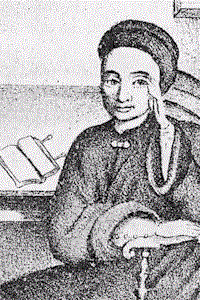Johannes Kelpius
A brief biography

Johannes Kelpius was born Johann Kelp in Transylvania in 1667, near the village of Sighisoara, the birthplace of the infamous Vlad the Impaler (the inspiration for Bram Stoker’s Dracula). After the death of his father in 1684, Johann was sent by three patrons to complete his education at Bavaria’s University of Altdorf, once one of Europe’s most respected institutions.
At the university, Kelp’s name was Latinized according to the custom of scholars of his day. By the age of 22, Kelpius graduated with a masters degree in liberal arts and philosophy. It is thought that while at the university he became acquainted with the Pietist religious movement. Pietism was initially a reaction against the formalism of orthodox Lutheranism, but spread to include a wide range of esoteric (and heretical) Christian philosophies.
One of the most charismatic figures in German Pietism was Johann Jacob Zimmerman, a brilliant mathematician, astronomer, and cleric. Zimmerman had been dismissed from his position as a Lutheran minister for preaching that the Lutheran Church was the Anti-Christ. In the years following his dismissal and subsequent exile, Zimmerman formed a small group named The Chapter of Perfection. This group was composed mostly of young men like Kelpius (who was then in his early twenties). Among the beliefs of this group was a conviction that a new spiritual age was dawning—their version of the 1,000 year rule of the returned Christ—and that it was necessary to prepare themselves and others for its arrival. This conviction was reinforced by Zimmerman’s unquestionable skill as an astronomer and his assertion that this new age was foretold in the heavens.
Probably around 1692, the Chapter of Perfection received an anonymous offer of free land in Pennsylvania and free passage there. America was regarded by the young Pietists to be a land untainted by the sins of European decadence, and the ordained place to await the final drama of mankind.
In August of 1693, near the time the group was about to depart for America, Zimmerman died, leaving the young Kelpius as the group’s spiritual leader. Kelpius was determined to complete Zimmerman’s mission, and after a remarkable sea voyage, the group arrived in the infant city of Philadelphia. Eventually Kelpius led his group to a ridge above the Wissahickon gorge, one of the oldest geologic formations in North America. There, along the fortieth parallel, Kelpius constructed a forty-foot square tabernacle, forty in his esoteric philosophy being a number of the highest mystical significance.
Kelpius and his comrades shared the benefits of their liberal education with the local settlers and served as teachers, healers, religious leaders, lawyers, philosophers, and scientists. Perhaps to avoid adding to the widespread conflict among the many religious sects that flourished at the time, Kelpius's community had no special name or tenets. They were often referred to collectively as "The Woman in the Wilderness," likely in reference to a passage in the Biblical book of Revelation, but perhaps as a code phrase understood only by the initiated.
For about ten years the community flourished, but the inherent conflict between a desire for spiritual seclusion and a desire to serve their fellow man proved to undermine their focus. Many of the members left and joined the burgeoning population of nearby Germantown. Kelpius himself became ill with tuberculosis and slowly declined in health. There is no official record of his death, but he is thought to have died in 1708 at the age of 41.
Kelpius left behind a collection of original hymns, a journal that includes many of his correspondences, and the authorship of a book on prayer and meditation. A remarkable account recorded about twenty years after his death, suggests that Kelpius had possessed the legendary Philosophers’ Stone, the mythical element that can cure all human ills. Having no one to whom to entrust this powerful substance after he died, Kelpius ordered a mysterious box to be thrown into the deep waters where the Wissahickon Creek empties into the Schuylkill River. The story goes on to say that when the box struck the water there was an explosion with “flashes of lightning and peals like unto thunder.”
Today, a small man-made cave in a remote wooded corner of Philadelphia's Fairmount Park is considered by many to have once been the meditation cell of the young mystically-minded spiritual teacher. A stone marker beside the cave claims Kelpius as America's first Rosicrucian master. Both the authenticity of the cave and the claim of Kelpius's position with the Rosicrucians are not conclusive.
An organization called the Kelpius Society is promoting new research and restoration of Kelpius's unique community.
The image above shows a detail of painting of Kelpius that has been attributed to his contemporary and friend, Christopher Witt

